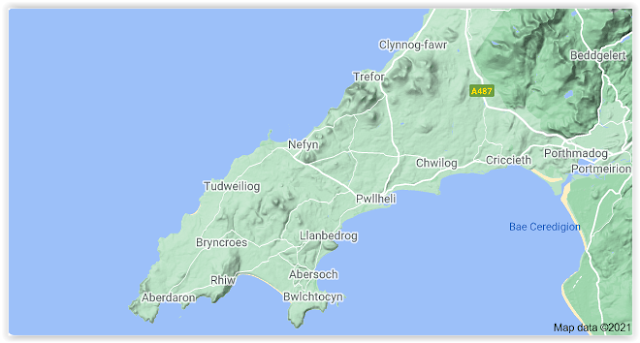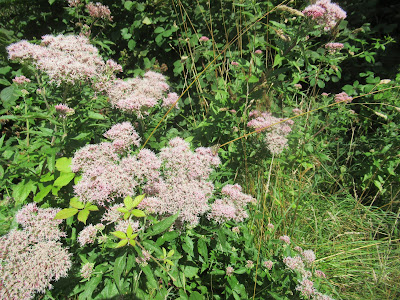Just home from a week with daughter Kim and others in the family to her home at the tip of the Lleyn Peninsula in NW Wales.This is the peninsula in North Wales running SW into Cardigan Bay.
 |
| This is the Lleyn Peninsula. Kim lives on the coast below the 'A' of Aberdaron. |
 | ||
| Trwyn Bychestyn is the name of the cliff at the top of their field. |
 |
| Kim's house, Ty'n Gamdda, peering out from the foliage. |
 This lower part of the field is left for flowers and insects and part will be cut for hay soon. Small Coppers, Common Blues and many other butterflies, grasshoppers and other insects use the meadow. A Dark Green Fritillary appeared a little while ago.
This lower part of the field is left for flowers and insects and part will be cut for hay soon. Small Coppers, Common Blues and many other butterflies, grasshoppers and other insects use the meadow. A Dark Green Fritillary appeared a little while ago.The field is divided into fenced-off areas so the sheep are grazed rotationally and some sections are cut early, some later.
Earlier in the summer, white male Ghost Moths were lekking over this meadow at twilight, looking for the orange-brown females waiting for them in the grass below. Their swaying flight low over the grass is quite ghostly. Kim stopped counting at sixty.
 |
| First Scything lesson. The hay is usually cut, turned and baled mechanically but a scythe is useful for small areas. |
 |
| Willughby's Leaf-cutter bee. Note the diagnostic tuft of orange hairs on the abdomen. (Photo from. 'A Field Guide to the Bees of Great Britain & Ireland' by Steven Falk & Richard Lewington.) |
We went for our usual cliff walk on Bychestyn, this time to get blackberries. The dry hot spell in July has parched the grass and there was no sign of the usual crop of big Parasol Mushrooms which Tony usually picks for an evening feast.
The fine cliff grasses are dry and the marshy flushes are dry and cracked.
At this time of the year the cliff is usually a patchwork of purple and gold of heathers and the late summer-flowering Western Gorse. This year the low mounds of gorse are covered with new young prickly growth but very little flower. It looks as if cold winds in the winter seered off the growth which usually flowers now, and is being replaced with new young growth which won't flower till next year (if it doesn't get blasted again.)
The Ling (Calluna vulgaris) flowers a bit later than the Bell Heather (Erica cinerea) which is beginning to turn from rich purple to russet brown.
The gorse is home to various spiders including this Funnel-web species.
Grayling Butterfly an upland and coastal butterfly. We seldom see it these days in our part of Cornwall. We saw several on the cliff and one in Kim's hay field.
They always rest with wings closed and leaning over a little. Good camouflage.
 | ||
| This inlet just to the south of Bychestyn has a very steep unclimbeable rock face at the head, known as The Parwyd. Most years Peregrines nest on this cliff but only a single bird appeared this year. |
 | |||
| The other end of Bychestyn. Grey seals watching us watching them. |
This is the time to see the Perseids, the meteor shower which can make a spectacle if the sky is clear. On the second night of our visit it was pretty windy but clear and our grandson met up with his old school pals on the cliff and they had good views. Kim went out to look on a few evenings and saw odd ones.
Already our visit was passing all too quickly and our planned exploration of a mountain area to the north east was put in doubt by bands of drizzle and extensive low cloud. However we set off with a visit first of all to an old gunpowder works, now a nature reserve on the Dwyryd estuary just beyond Penrhyndeudraeth. Kim had never been there either.
Portmerion is the eccentric Italianate village constructed about a hundred years ago by the architect Clough Williams-Ellis.A local fisherman told us that Ospreys hunt for fish in the estuary here when the tide comes in, and Cormorants roost on the pylon in the salt marsh on the right of the picture.
 |
Looking up the estuary. The meat from the sheep which graze the salt marshes and grassland in the estuary fetches a premium price due to this sweet feeding ground.
Birch and heathers are invading the old powder works.
It's a particularly good year for Rowan berries. We noticed huge crops in all the rowans as we traveled up through the Welsh mountains to get to Kim's place.
 | ||
| The gunpowder works made a dam near the top of the hill. It is now a good habitat for dragonflies and other aquatic insects. |
Heathland with Ling and Western Gorse on the top of the hill, looking north. One of the main features of the reserve are the Nightjars which can be seen and heard at dusk in July.
By mid-day the low cloud over the mountains seemed to be lifting and so we decided to go on north east., through the slate country of Blaenau Ffestiniog to an upland area neither Kim nor we know at all.
 | |||
| The road skirts round a huge area of wet upland moor and mire known as Migneint. At around 200 square kilometres this is one of the most extensive areas of blanket bog in Britain. |
 | |||||||||
| The River Conwy rises in this country | . |
Pont ar Gonwy where the road crosses the river Conwy over this uncompromising little slate bridge.
 | |||
| Migneint plunges down steep valleys on the north side. Some coniferous plantation still standing, some clear-felled and some apparently naturally regenerating. |
There are old stone-walled sheepfolds in the bottom of this valley, Cwm Hafodrhydin.
Numerous little streams tumble down high waterfalls into this valley. Lemon-scented and Beech Ferns grow in the shady gullies and the insectivorous plant Butterwort (right) grows on the wet rock faces.
 | |||
| The valleys from Migneint run north to the Penmachno valley which goes north towards Bettws -y- Coed. |
| We had strayed far enough from home by now and headed back west in still very unsettled weather. |
Heading back west. The humps and bumps of the Lleyn Peninsula, are ahead. They are the remains of ancient volcanoes.
Another day's exploration was nearer home, to the marshy valley of one of the two rivers which join and run to the sea at Abersoch, the well-known sailing and holiday little town along the coast from Kim's nearest village of Aberdaron.
 | |||
| The wet heathland looking towards Abersoch. |
The track running down one side of this area of common land. Butterflies and dragonflies patrolled in the sun.
 | |
| Darter Dragonfly....the photographer photographed! |
Just before we left to come home, we were joined by son Angus and his younger son, so we overlapped for a day. They set up a saltwater aquarium so after the hens, sheep, new pond, the cliff and the garden had all been toured, we spent some hours on the coast a couple of miles to the north.
 |
| Looking for leeches? |
But we did find a Water Scorpion in the mud at the side of the pool.
I find this insect belongs to the group of 'true Bugs which include Shield Bugs and Froghoppers (which make cuckoo-spit.)
 |
| Just testing the new pond! Brennie dived in. |
It was a good visit, as varied as ever, from the wide horizons of the Irish Sea to the west and the undulating moorland of Migneint stretching into the distance, to the close-up views of the leaf-cutter bees and the livestock in the aquarium.




























A favourite part of the world for us.
ReplyDeleteThank you Mary for the detail about the surrounding landscape. On a bigger scale than our little patch on Bodmin Moor. J
ReplyDelete